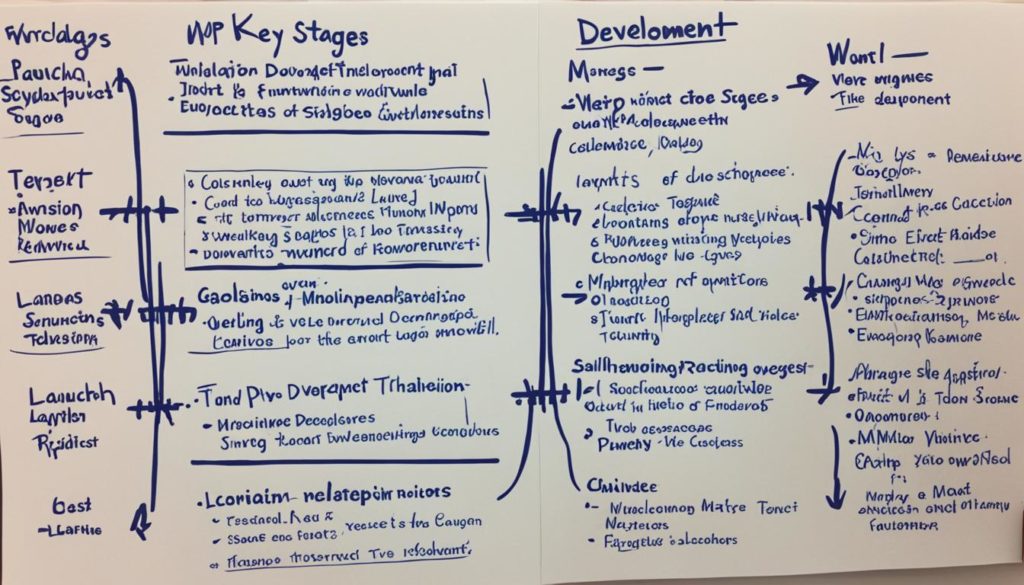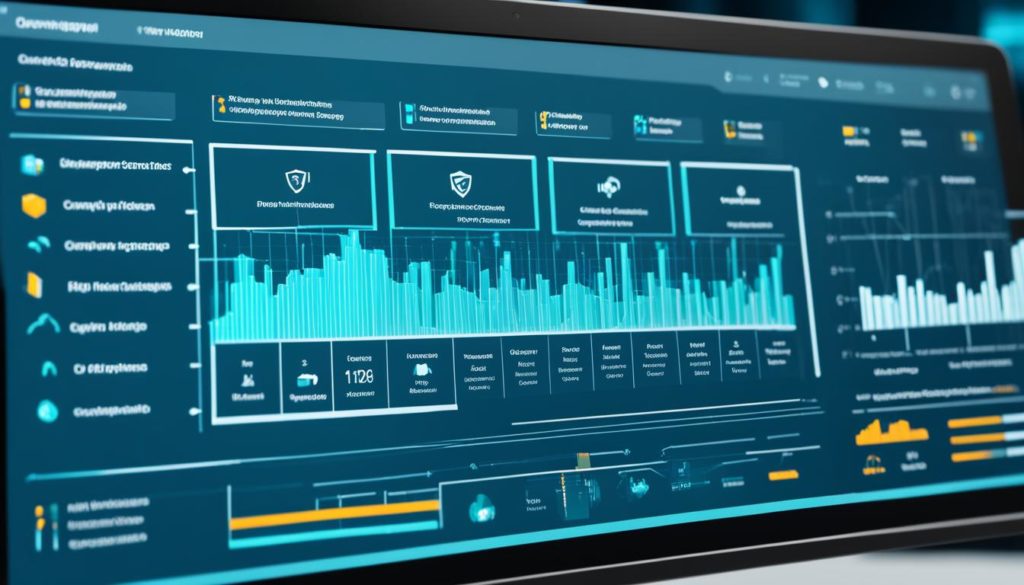
Did you know that since 2012, HackerOne has helped find over 200,000 vulnerabilities? In today’s world, strong cybersecurity is more important than ever. Bug bounty programs let ethical hackers find and report bugs in software or websites for rewards.
These programs help fix threats before bad guys can use them. They make the internet safer and reward those who help keep it safe.
Platforms like HackerOne, Bugcrowd, and Synack change how companies find and fix bugs. Beginners should join public bug bounty programs from well-known companies. This way, ethical hacking becomes a team effort.
It helps everyone work together to make the internet safer. Bug bounty programs welcome talented people from all over to help make the digital world safer.
Key Takeaways
- Bug bounty programs incentivize security researchers to uncover software vulnerabilities.
- Over 200,000 vulnerabilities have been found through HackerOne since 2012.
- Ethical hacking fosters a collaborative cybersecurity approach.
- Beginners should start with public programs by reputable companies.
- Clear communication and detailed reporting are crucial for success in bug bounty programs.
Understanding Bug Bounty Programs
Bug bounty programs are key in today’s cybersecurity defense. They let companies find and fix security issues with help from ethical hacking experts. These programs pay hackers to find and report bugs, helping both companies and hackers.
What are Bug Bounty Programs?
Bug bounty programs let people find and report bugs in systems for money. Sites like HackerOne help run these programs. For example, Google’s VRP in 2017 paid up to $31,337 for big security finds in Google Play apps.
Benefits of Bug Bounty Programs
Bug bounty programs have many benefits. They attract many people, from beginners to experts, to help find bugs.
- In 2022, Google gave its biggest bounty ever, $605,000, for a big find.
- Meta has paid over $16 million since 2011, with $2 million in 2022.
- The Department of Defense’s “Hack the Pentagon” in 2016 found nearly 7,000 bugs, paying $71,200.
These examples show how bug bounty programs improve internet security by finding bugs that might be missed by company teams.
Who Can Participate?
Anyone with ethical hacking skills and a love for IT security can join bug bounty programs. This is shown by the many different people who submit bugs to programs. For example, India was the top country for bug submissions to Facebook’s Whitehat program in 2017.
People from all over join, from new researchers to experienced hackers. Public programs are open to everyone, while private ones are for a chosen few. This ensures the right bugs are found and reported.
Bug bounty programs are a way for companies and hackers to work together. They help make systems and apps safer by using platforms like HackerOne and Bugcrowd.
| Year | Notable Programs | Significant Milestones |
|---|---|---|
| 1995 | Netscape Communications Corporation | Launched the first “Bugs Bounty” program for Navigator 2.0 |
| 2016 | Department of Defense | Uncovered nearly 7,000 vulnerabilities |
| 2017 | Google VRP | Expanded to include apps from Google Play, rewards up to $31,337 |
| 2019 | European Commission | 195 unique vulnerabilities in open source projects |
| 2022 | Google VRP | Largest bounty announced at $605,000 |
Getting Started in Bug Bounty Hunting
Starting your bug bounty hunting journey needs more than just curiosity. As white hat hackers, knowing the basics and picking the right tools is key. This will improve your skills and help you build a strong reputation in the field. Let’s explore what it takes to begin bug bounty hunting.
Essential Skills for Bug Bounty Hunters
To excel as a bug bounty hunter, you must have a solid foundation in several areas. Understanding security systems, network protocols, and web app security is crucial. Practical experience in penetration testing is also vital.
Learning from developer mistakes that cause vulnerabilities is a smart strategy. For example, platforms like BugBountyHunter offer challenges that teach you about common flaws like Cross-Site Request Forgery (CSRF).
Choosing the Right Platform
Choosing the right platform is key to your success in bug bounty hunting. Platforms like HackerOne and Bugcrowd have programs for all skill levels. HackerOne CTF challenges and Bugcrowd’s Discord channel are great places to start.
These platforms let you explore top exploits and learn various techniques. Private tool challenges and real-life web app vulnerability reports are also great learning tools.
Resources for Learning and Development
There are many resources to help you improve in bug bounty hunting. Online courses, forums, and blogs are all available. Guides like “Web Hacking 101” and the OWASP Top 10 are good starting points.
Practical experience on platforms like BWAPP and DVWA helps turn theory into practice. Knowing networking, HTTP protocols, and how the internet works is essential. Focus on learning about server-side request forgery (SSRF) in different programming languages to improve your skills.
Using these resources and joining communities can greatly enhance your skills. Remember, bug bounty hunting is not just about finding bugs. It’s also about responsible disclosure, which makes the internet safer for everyone.
How Bug Bounty Programs Work
Understanding bug bounty programs is key to seeing their role in cybersecurity. These programs start with rules and a clear scope. They define which domains and vulnerabilities are eligible for rewards.
Then, ethical hackers can start looking for vulnerabilities. They follow the rules set by the program.
When a hacker finds a vulnerability, they report it through a special platform. The report must show how to reproduce the flaw and its security risks. This makes sure the findings are clear and useful.
After a report is submitted, it goes through a detailed vulnerability assessment. The team checks the vulnerability’s severity and impact. They then decide which vulnerabilities to fix first.
Fixing vulnerabilities is the next step. Companies use their cybersecurity mechanisms to patch the flaws. Once fixed, the hackers get rewards based on the bug’s importance.
This method brings in many different views, making digital safety better for businesses. Public bug bounty programs attract more people, while private bug bounty programs offer more control. In-house programs need a lot of resources and cybersecurity expertise.
Companies can release their software sooner with these programs. They get thorough testing, even with early bugs. Finding the right number of hackers is also key. Their work helps keep security strong.
Strong bug bounty programs improve security and help companies make more money. They help both big and small vendors. This creates a global community working to improve cybersecurity.
Well-Known Bug Bounty Platforms
Many platforms connect companies looking for security checks with ethical hackers. These platforms have special features that make them key in the world of cybersecurity. Let’s look at some of the most respected ones.
HackerOne
HackerOne is famous for its big network of ethical hackers and easy-to-use interface. By 2019, it had raised $110 million, making it a leader in bug bounty. It has a big, active community and works with big names like the U.S. Department of Defense and European Commission.
Bugcrowd
Bugcrowd uses a team effort to improve security, with a wide range of researchers. In April 2020, it got $30 million to grow its platform, reaching $78.7 million in funding. It’s known for its managed services, making it easier for companies to check for vulnerabilities.
Synack
Synack uses artificial intelligence and human skills for detailed security tests. It was named the most trusted crowdsourced security platform in May 2019. Its strong features draw in clients who need top security.
Cobalt
Cobalt offers a unique Pentest as a Service (PtaaS) model. It provides regular, on-demand pen-testing with feedback. This model helps companies stay secure without the high costs of traditional pen-testing. Cobalt’s approach is structured and scalable, making it popular among companies.
Open Bug Bounty
Open Bug Bounty is a non-profit that supports responsible vulnerability disclosure. It lets ethical hackers report security issues directly to website owners. This helps make the internet safer for everyone. Its community-driven model is great for smaller companies that can’t afford big security tests.
FAQ
What are Bug Bounty Programs?
Bug bounty programs are a way for companies to pay people to find security problems. These programs help find bugs in software and systems. This makes the digital world safer.
What are the Benefits of Bug Bounty Programs?
Bug bounty programs help keep companies safe by finding security risks. They also let hackers earn money and get recognition. This makes the internet a safer place for everyone.
Who Can Participate in Bug Bounty Programs?
Anyone can join bug bounty programs, from beginners to experts. These programs welcome people with all kinds of IT security skills.
What Essential Skills Are Needed for Bug Bounty Hunters?
Bug bounty hunters need to know a lot about security. They should be good at network protocols, web security, and penetration testing. Knowing cybersecurity is key to being successful.
How to Choose the Right Platform for Bug Bounty Hunting?
Picking the right platform is important for bug bounty hunting. Sites like HackerOne and Bugcrowd offer different features. Choose one that fits your skills and interests.
What Resources Are Available for Aspiring Bug Bounty Hunters?
There are many resources for new hunters. Online courses, blogs, and forums offer tips from experts. These resources help beginners learn and start their hacking journey.
How Do Bug Bounty Programs Work?
Companies set rules for bug bounty programs. Hackers look for bugs and report them. Then, the company fixes the bugs and rewards the hunters based on the bug’s importance.
What is HackerOne?
HackerOne is a big bug bounty platform. It connects companies with hackers to find and fix security issues. It’s known for being easy to use.
What is Bugcrowd?
Bugcrowd focuses on teamwork in security. It brings together hackers to find and fix bugs. This helps make companies’ security better.
What is Synack?
Synack uses AI and human hackers for security tests. It finds bugs that others might miss. This makes security assessments more thorough.
What is Cobalt?
Cobalt offers continuous security checks through a community of hackers. It helps companies find and fix security problems quickly. This makes security easier to manage.
What is Open Bug Bounty?
Open Bug Bounty promotes safe bug reporting. It encourages hackers to report bugs openly. This helps companies get better at security and supports ethical hacking.
Future App Studios is an award-winning software development & outsourcing company. Our team of experts is ready to craft the solution your company needs.










